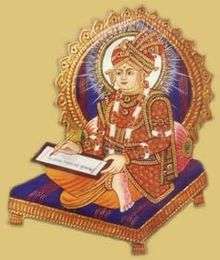Shikshapatri

| Part of a series on |
| Hindu scriptures and texts |
|---|
 |
|
Rig vedic
Sama vedic Yajur vedic Atharva vedic |
|
Other scriptures |
| Related Hindu texts |
|
|
|
Timeline |
The Shikshapatri (Gujarati: શિક્ષાપત્રી, Devanagari: शिक्षापत्री) is a religious text consisting of two hundred and twelve verses, written in Sanskrit by Swaminarayan.[1] - Lord himself. The Shikhapatri is believed to have been written in the current form in Sanskrit by Satanand Swami, who incorporated into and complied the scripture known as SatsangiJivan. The Shikshapatri is a key scripture to all followers of Swaminarayan and is considered the basis of the sect.
The Shikshapatri was written in Vadtal on February 11, 1826.[2] It is a dharma text, providing detailed instructions on how to live a spiritually uplifting life.
Summary of teaching
The Gazeteer of the Bombay Presidency summarised the teachings of the Shiskshapatri as:
The book of precepts strictly prohibits the destruction of animal life; promiscuous intercourse with the other sex; use of animal food and intoxicant liquors and drugs on any occasion, suicide, theft and robbery; false accusation against a fellow man; blasphemy; company of atheists and heretics, and other practices which might counteract the effect of the founder's teaching. [3]
Governor Sir John Malcolm
On February 26, 1830 a historic meeting took place between Swaminarayan and Sir John Malcolm, the then Governor of Bombay. At this meeting, Swaminarayan presented a copy of the Shikshapatri to Sir John Malcolm. This copy is now housed at the Bodleian Library of the University of Oxford. [4][5] Acharya Tejendraprasad of Ahmedabad has indicated in a letter that he is not aware of any copy from the hand of Sahajanand older than this text.[6]
Languages
Swaminarayan instructed Nityanand Swami to translate Shikshapatri from Sanskrit into Gujarati. It has since been translated numerous times into other languages. It has been translated to Bengali, Gujarati, Hindi, Marathi, Tamil, Telugu, Udiya, Urdu, Vraj, Afrikaans, Arabic, Chinese, Dutch, English, Finnish, French, German, Greek, Italian, Modern Hebrew, North Sotho, Portuguese, Russian, South Sotho, Spanish, Swahili, Xhosa, and Zulu,[7]
Notes
- ↑ http://www.swaminarayan.nu/sampraday/shiksha.shtml Shikshapatri (in English)
- ↑ http://www.swaminarayan.org/scriptures/shikshapatri/index.htm Shikshapatri
- ↑ M. G. Chitkara (1997). Hindutva. APH. Retrieved March 26, 2009. Page 230
- ↑ Raymond Brady Williams (2004). Williams on South Asian religions and immigration. Ashgate Publishing Group. Retrieved March 26, 2009. Page 57
- ↑ Sri Swaminarayan, Digital Shikshapatri, Bodleian Library, Oxford University
- ↑ http://www.shikshapatri.org.uk/~imagedb/content.php/psjm
- ↑ http://www.swaminarayan.org/essays/2007/0801.htm Swaminarayan's Shikshapatri
External links
- Digital Shikshapatri Provides a wide variety of online resources which set the Shikshapatri in its historical, cultural and religious context - The oldest copy of the Shikshapatri in the world today is shown, in digital form.
- provides a shikshaparti in Gujarati by Gadhada Swaminarayan temple.
- http://www.bhujmandir.org/library/scriptures/
♥
